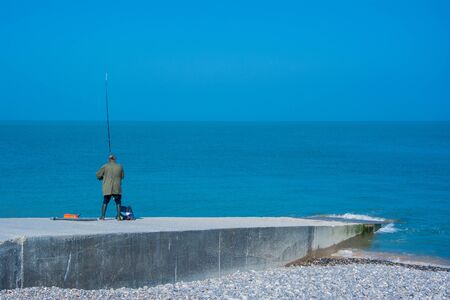1. Understanding Tides for Successful Pollock and Ling Sessions
If you’re hoping to maximise your chances of landing quality pollock or a hefty ling along the British coastline, it’s crucial to develop a deep understanding of tidal movements. The ever-shifting tides around the UK are more than just background scenery; they shape the underwater world, dictate fish behaviour, and influence feeding windows. Pollock, with their preference for hunting in strong currents near kelp beds and rocky drop-offs, often become most active as the tide begins to flood or ebb. Ling, meanwhile, favour the deeper gullies and wrecks—locations where tidal flow stirs up prey and increases feeding opportunities. In many classic UK marks—be it Cornwall’s rugged headlands, Northumberland’s deep water ledges, or Scotland’s island channels—the state of the tide can make all the difference between a blank session and a memorable haul. Anglers in the know carefully time their casts to coincide with periods of increased water movement: typically an hour before and after high or low tide. During slack water, both pollock and ling tend to be less active as baitfish disperse and the natural conveyor belt of food slows down. By tuning into these subtle yet powerful tidal rhythms—and tailoring your approach to suit local nuances—you’ll unlock some of the finest sea fishing experiences Britain has to offer.
2. Weather Wisdom: Reading Conditions for Productive Fishing
British sea fishing is an ever-evolving dance with the elements, and seasoned anglers know that a keen eye on the weather can be just as important as bait choice when targeting pollock and ling. Understanding how wind, rain, barometric pressure, and cloud cover interact with local tides transforms an average outing into a red-letter day on the water.
Wind: Friend or Foe?
Wind direction and strength are pivotal in shaping your fishing success. Onshore winds (blowing from the sea to land) often stir up nutrients close to shore, luring smaller fish—and in turn, hungry pollock and ling—within casting distance. Conversely, strong offshore winds can flatten waves but may disperse shoals further out, making them harder to reach from the rocks or beach. Moderate breezes from the southwest are typical along much of the UK coastline and often bring mild, productive conditions.
Rain and Cloud Cover: Light Levels Matter
Overcast skies or light drizzle can work wonders for pollock and ling fishing. These species are less wary under low-light conditions, often venturing closer to shore to hunt. Heavy rain, however, may reduce water clarity too much, making lure presentation difficult. Still, don’t be put off by a bit of mizzle—a classic British “soft” day can see action pick up as predatory fish take advantage of reduced visibility.
Barometric Pressure: Subtle Signals
Changes in atmospheric pressure subtly influence fish behaviour. A falling barometer typically signals unsettled weather and can trigger feeding frenzies as fish sense a change coming. In contrast, high pressure brings settled, clear days—often beautiful for humans but potentially slowing down bites as fish become lethargic or head for deeper water.
| Weather Factor | Impact on Pollock & Ling | Best Tactics |
|---|---|---|
| Onshore Wind | Pushes baitfish inshore; improves chances near rocks/structure | Cast lures/plugs into surf zones; use heavier weights if swell increases |
| Cloud Cover/Light Rain | Encourages feeding near surface and close to shore | Fish dawn/dusk or during overcast spells; try shallow-diving lures |
| Falling Barometer | Sparks active feeding before storms/fronts arrive | Increase session length before weather turns; focus on known hotspots |
| High Pressure/Sunshine | Bites may slow; fish move deeper or become cautious | Use natural baits at depth; scale down tackle for subtlety |
The unpredictable British weather keeps every angler humble—but with a touch of observation and adaptation, you’ll find yourself better equipped to make the most of whatever Mother Nature throws your way.
![]()
3. Seasonal Shifts: When Pollock and Ling are Most Active
Understanding the rhythm of the British seasons is key to unlocking the secrets of pollock and ling behaviour. Both species are distinctly influenced by our shifting weather, sea temperatures, and daylight hours, making your timing almost as crucial as your tackle.
Spring Awakening
As winter’s grip loosens, rising water temperatures spark a surge in activity. Pollock begin to move inshore from their deeper winter haunts, chasing shoals of sandeels and sprats in search of food. Ling, meanwhile, linger around wrecks and rocky outcrops but start feeding more vigorously as spawning approaches. Late spring offers some of the best action for both species, especially along rugged Cornish headlands or Scotland’s exposed coastlines.
Summer Abundance
The long days and warming seas see pollock at their most aggressive near kelp beds and reefs. Their vivid golden flanks shimmer just below the surface, making them a prime summer target—especially during early morning or late evening tides when they prowl for prey. Ling generally stick to deeper structure but can be enticed with fresh bait as they recover from spawning. For both fish, a calm high-pressure spell is ideal—think balmy evenings on a gently heaving Bristol Channel or Northumberland rock mark.
Autumn Opportunities
As autumn sets in, cooling waters trigger feeding frenzies before the leaner winter months. Pollock pack on weight for migration to deeper wintering grounds, often striking lures with reckless abandon. Ling, too, feed hard ahead of winter storms—this is prime time for specimen hunters seeking trophy-sized fish lurking around wrecks off Devon or Yorkshire.
Winter Lull and Local Knowledge
The coldest months see pollock retreating offshore into deeper, more stable waters, though in milder regions like Cornwall or the Irish Sea you might still find resident populations inshore on calmer days. Ling remain catchable over deep wrecks and reefs if you’re willing to brave harsher conditions—a true test of grit and preparation.
Timing Your Trips for Success
Aligning your fishing with these seasonal cues—whether it’s a spring dawn raid for pollock off Pembrokeshire or a windswept winter ling session in Shetland—can transform an ordinary outing into an unforgettable session. Keep an eye on local reports, water temperature charts, and historical catch data to refine your timing further; after all, nature rewards those who observe her subtle changes with patience and respect.
4. Best Locations: Tying Conditions to the UK’s Varied Coastline
When targeting pollock and ling along Britain’s diverse coastline, understanding how tides, weather, and seasonality influence your choice of venue is essential. The interplay between these factors and your fishing location can be the difference between a blank session and a memorable catch.
Rocky Marks: Harnessing Movement and Cover
Rocky headlands and outcrops are classic haunts for pollock, especially during spring and autumn when baitfish are abundant close to shore. These areas provide both ambush points and shelter. For best results, target rocky marks during the last two hours of the flood tide or first hour of the ebb, as moving water stirs up prey and encourages predatory activity. Overcast days or light drizzle can make fish bolder, while settled weather in late spring brings larger pollock inshore. Ling often lurk in deeper gullies within these structures, so dropping down baits at slack water can yield surprises.
Piers: Access to Depth with Urban Convenience
Piers offer easy access to deeper water without a boat, making them a year-round option. During winter storms or rough seas, piers shield anglers from the worst of the weather while still presenting baits to ling that move closer in search of food dislodged by turbulent conditions. Early mornings on rising tides are particularly productive for pollock as they follow shoals of fry under the structure. If you’re after ling, focus on dusk or night sessions when they become more active around pier legs and debris.
Deeper Waters: Offshore Adventure
If you have access to a charter or your own boat, offshore reefs and wrecks come into their own from late spring through early autumn. Here, tidal strength is crucial—moderate flows keep baitfish moving without making it impossible to hold bottom. Pollock thrive around wrecks on neap tides when visibility is good but current isn’t overwhelming. Ling are best targeted in deeper waters with fresh mackerel baits during strong tidal runs.
Quick Reference Table: Matching Conditions with Locations
| Location Type | Best Tide | Optimal Weather | Top Season | Target Species |
|---|---|---|---|---|
| Rocky Marks | Flood/Ebb (High Water) | Overcast/Drizzle | Spring/Autumn | Pollock/Ling |
| Piers | Rising/High Tide | Mild/Stormy (Winter) | All Year (esp. Winter) | Pollock/Ling |
| Deep Water (Boat) | Neap/Moderate Flow | Settled/Fair | Late Spring–Autumn | Pollock/Ling |
The secret to consistent success lies in matching your venue not just to your target species, but also to the prevailing conditions—think like a fish, react like an angler, and let Britain’s coastal diversity work in your favour.
5. Tackle and Bait Choices: Adjusting for Environment and Behaviour
If you’re to get the most out of your sea fishing sessions for Pollock and Ling around British shores, choosing the right tackle and bait is as crucial as reading the tides or watching the weather. The UK’s changeable conditions demand a thoughtful approach—what works on a calm summer evening off Cornwall can be utterly different from what’s needed in choppy autumn waters along the Scottish coast. Here’s how to optimise your gear and bait for these ever-changing environments.
Rods, Reels, and Line Selection
The robust nature of both Pollock and Ling means you’ll need kit that stands up to a fight. For inshore marks where kelp beds abound, a 10-12ft medium-heavy rod paired with a reliable fixed spool reel is ideal. Opt for braided mainline—20-30lb breaking strain gives you the sensitivity to detect subtle bites yet enough muscle to steer fish clear of snags. When venturing offshore or targeting deeper wrecks, a boat rod rated up to 50lb with a sturdy multiplier reel ensures you’re prepared for larger specimens, especially when tides are running hard.
Terminal Tackle: Adaptability is Key
Weather shifts can influence water clarity and current strength. On bright, settled days with clear water, scale down your end tackle: lighter fluorocarbon leaders (around 20lb) and smaller hooks (size 2/0–4/0) make presentations more natural, enticing wary fish. After storms or on spring tides when visibility drops, don’t be shy about bulking up—heavier traces and larger hooks help cope with debris and aggressive takes.
Bait Choices: Matching the Menu to Conditions
Both Pollock and Ling respond well to natural baits like mackerel strips, squid, or cuttlefish, but their preferences shift with season and weather. In colder months or after rough seas, fresh baits emit strong scents that attract fish in murky water. During high summer or neap tides, lures such as jelly worms or shads in natural hues can outfish bait—especially for Pollock patrolling weed edges in bright light. Always carry a selection of both baits and lures to adapt on the fly.
Local Knowledge: The Edge You Need
Don’t overlook what seasoned local anglers have learned over decades. Visit your nearest tackle shop; they’ll know which rigs are working best given recent wind patterns and tide states. Simple tweaks like adding beads or luminous attractors can make all the difference when conditions are challenging.
Ultimately, being flexible with your tackle and bait choices allows you to meet the demands of shifting British seas—and puts more Pollock and Ling on your line whatever Mother Nature throws at you.
6. Safety and Comfort: Preparing for British Conditions
When targeting pollock and ling along the UK coastline, staying safe and comfortable is just as important as reading tides or selecting the right lure. The British seaside is notorious for its unpredictable weather—one moment you’re basking in gentle sunshine, the next you’re battered by wind-driven drizzle. To truly enjoy your session and fish effectively, preparation is key.
Dress for Success: Layering Is Essential
Start with a moisture-wicking base layer to keep sweat off your skin, then add insulating mid-layers such as fleece or wool. Always top it off with a quality waterproof and windproof jacket and trousers—a proper set of waterproofs can make all the difference when Atlantic squalls roll in. Don’t forget a warm hat and fingerless gloves, especially if you’re handling cold tackle at dawn or dusk.
Footwear: Stay Upright and Dry
Rocky marks and slippery harbour walls call for sturdy, grippy boots or wellies with good ankle support. Wet feet are miserable feet; invest in thick wool socks and ensure your footwear is properly waterproofed before each trip.
Keep an Eye on the Elements
Always check the local tide tables and weather forecast before setting out. Sudden changes in wind direction or rising tides can catch even seasoned anglers off guard. It’s wise to carry a fully charged mobile phone in a waterproof pouch, and let someone know where you’ll be fishing—especially on remote headlands or cliffs.
Packing Essentials for Comfort
A flask of hot tea or coffee is a true British comfort against biting winds, while a compact shelter or windbreak offers respite during long sessions. Bring extra dry clothing in a sealed dry bag; there’s nothing like changing into something warm after an unexpected soaking from spray or rain.
Respect the Sea—Stay Safe
No fish is worth risking your safety. Watch your footing on wet rocks, avoid turning your back to heavy swells, and never fish alone in dangerous conditions. With mindful preparation, you’ll not only maximise your chances of landing pollock and ling but also ensure every outing is enjoyable—rain or shine.


